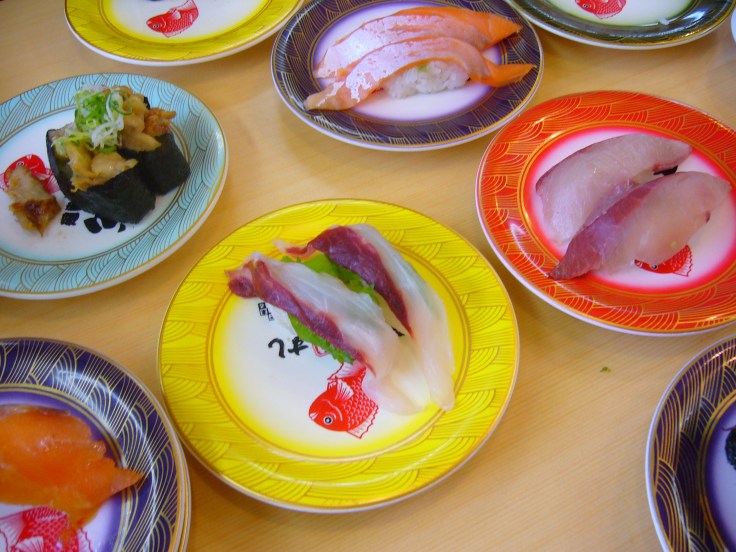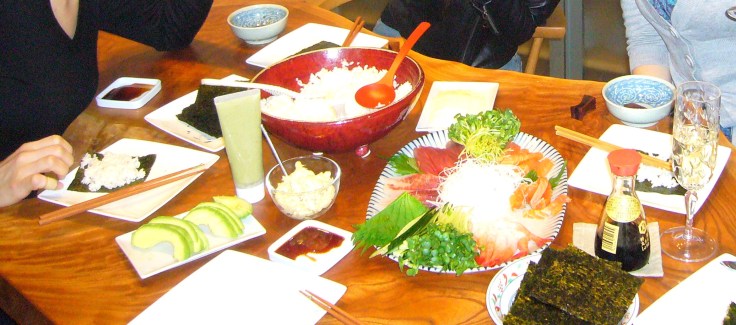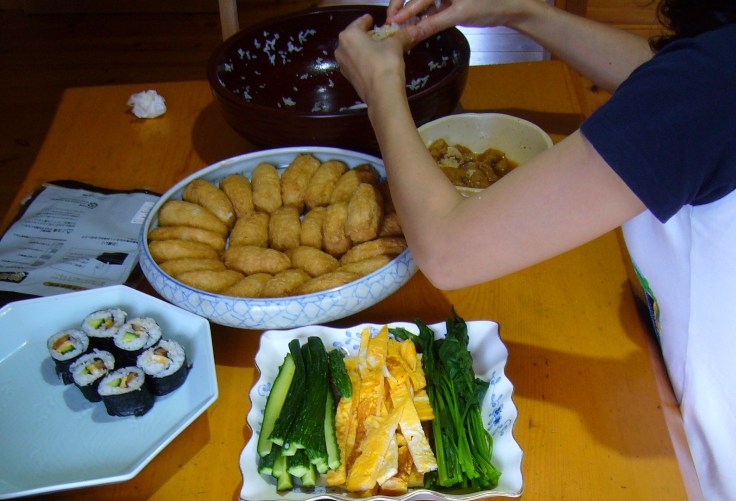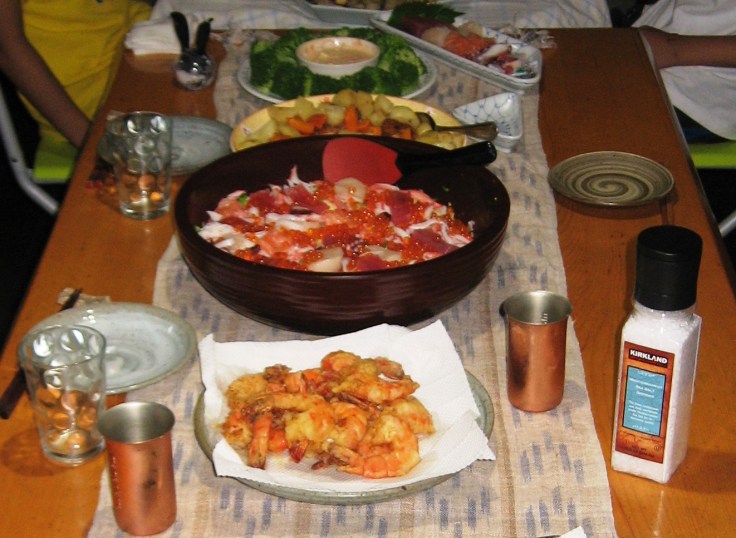Japan has a type of sushi for every occasion. In the West, we often have a very limited view on sushi. When Belgian people think of sushi, they generally think of sushi rolls, as pictured below:

This type of rolled sushi, wrapped in nori seaweed, is called makizushi (which literally means ‘sushi roll’). In my experience however, this is not the most common kind of sushi in Japan. When you go to a sushi restaurant, you will mostly eat nigirizushi (meaning ‘hand pressed sushi’). Nigirizushi is a rectangular piece of rice with a large sliver of raw fish or seafood on top.

There is also a particular kind of nigirizushi that is quite common in sushi restaurants, called gunkanmaki. Gunkanmaki means ‘warship roll’. It is the same oblong base of rice as nigirizushi, with a fish or shellfish topping, but wrapped in a piece of nori. The nori serves to keep the topping of the gunkanmaki in place. It is usually prepared with softer toppings or some kind of fish eggs, which benefit from the structural support of the nori. In the picture below you see a gunkanmaki with sea urchin roe, but the most common kind is with salmon roe.


But despite the dominance of the nigirizushi, you do encounter makizushi (sushi rolls) in Japan. It is possible for a meal at a sushi restaurant to include a few pieces of makizushi, but they are mostly very plain and meant to top off your meal with something cheap and neutral tasting to fill up on, rather than being the focus of the meal. They are also quite thin. This kind of thin, plain makizushi is called hosomaki, which means ‘thin rolls’.

The variety of makizushi that we see most often in the West is called futomaki. This means ‘thick rolls’. In the West, these sushi rolls are filled with a variety of ingredients, usually some kind of raw fish with several other ingredients in one roll. Sometimes they are fried as well. In Japan, futomaki are usually vegetarian. Futomaki is popular during the Setsubun holiday, when it is considered good luck to eat an entire, uncut futomaki roll while facing that year’s lucky direction, as determined by the zodiac symbol of that year.

There are some other types of sushi that I mostly came across outside of sushi restaurants. One of those is temaki. This literally means ‘hand roll’. I saw this kind of sushi at sushi parties at people’s homes. At a sushi party, people put all the ingredients for sushi out on the table, the guests compose their own sushi cone to their liking and eat it at once. The procedure is repeated until everyone has had their fill.


Inarizushi is another type of sushi that is fairly unknown in the West. Inarizushi does not contain any fish. It is an oval rice ball, wrapped in a pouch of fried tofu. It is one of the cheapest kinds of sushi. Inarizushi is a popular ingredient of homemade bento lunch boxes.

Another lesser known form of sushi is chirashizushi, which means ‘scattered sushi’. This is a bowl of sushi rice (i.e. rice seasoned with vinegar), topped off with raw fish. It is typical of Hinamatsuri, the doll festival on March 3rd, but it is also eaten the year round.

Finally we might consider sashimi, which is raw fish and shellfish. By many Westerners, sashimi is mistakenly considered to be a form of sushi. While sushi and sashimi are often served in the same restaurant, they are not the same thing. The main difference is that sushi always involves rice while sashimi is raw fish without rice. Sashimi must always be eaten with chopsticks while sushi may be eaten with the hands if one so chooses.

What is your favourite type of sushi?
Greetings from Belgium 😉 Nice article and great pictures to explain the various types of sushi.
Thank you! 🙂
i much prefer nigirisushi and chirashisushi over any other types of sushi. then again, i secretly like inarisushi. im a fan of tofu products.
I love tofu as well! When people ask me what my favourite Japanese food is, I am always torn between tofu and sushi. I hate to say sushi because it is so cliché, but I can’t help loving it 🙂
lol. yeah, both are good. as for me, it would be tough to choose if the choice was between tofu and rice. but between tofu n sushi, well, i may go with tofu as it can be made into so many different dishes. i’m greedy that way 🙂
They are very poisonous photos to my eyes. I wish “piece of fish to be twice the size of the piece of rice” in UK…
Haha, same here. Writing this post made me really miss Japan and all the delicious sushi I had there.
My favorite is sashimi, but since you asked for favorite sushi I’ll go with nigirizushi from the kaitenzushi chain Kurazushi! It is so very good and so very cheap. I think my favorite there is the salmon-mayo-raw onion nigiri.
I don’t know Kurazushi. What region of Japan are you staying in? In Toyota City, we always went to Kappazushi for a 100yen sushi restaurant. It had a bad reputation among Japanese people apparently, but I greatly preferred it to sushiro (another 100yen kaitenzushi). But more often than not we went to Totomaru, a slighter higher quality kaitenzushi restaurant. On average we went there about once a week! I love me some salmon, but I also really liked the hotate nigiri.
When I lived in Aichi I went to Kappa a few times, not bad. In Kansai it’s mostly Sushiro and Kurazushi though, and like you I’m not a big fan of Sushiro. Their sushi often tastes like it’s been out for a long time. We are huge Kurazushi fans!
great post. My favourite are futomaki but I’m very intrigued by Inarizushi: I didn’t know it at the time I went to Japan! …so I guess I have to go back again. 🙂
I think they sell those fried tofu pouches in Japanese supermarkets abroad. I also found a recipe online to make them from regular abura age that you can also buy in Japanese supermarkets. And I also found a recipe for the sweet sauce. If you are really curious, you could try making inarizushi for yourself.
recipe 1: http://www.japanesecooking101.com/inarizushi-inari-sushi-recipe/
recipe 2: http://www.justonecookbook.com/recipes/inari-age/
Thank you!
My mother’s family always used to eat futomaki during new year’s holidays as a family tradition, the reason probably being you could serve a lot of people and my grandmother probably liked it.
The “tradition” of eating futomaki for setsubun was made popular by Seven Eleven fairly recently though it is said that the tradition did exist mainly in Osaka. I lived in the west as a kid but no one followed it at the time. 😉
I didn’t know that about Seven Eleven. Thanks for telling me! I first heard about it from people in Toyota City but afterwards I did read on Wikipedia that it is mostly a Kansai thing.
I might try making futomaki myself sometime soon. A friend asked me to teach her, probably not realizing that I have only done it twice myself. But I will do my best! 🙂
Yeah the setsubun futomaki is very popular in Osaka. And I love futomaki from the supermarkets, the ones filled with fried pork are so good.
Sounds interesting. I will look for it next time I am in Japan.
I’m not a big fan of vinegar, so sashimi is my favorite! Though I’m glad I’ve learned to appreciate sushi so that I can enjoy kaitenzushi restaurants, though I’m usually happy with not terribly adventurous kinds of nigirizushi. Inarizushi is one of my favorite bentou fillings.
Do you know what they use to soak the inarizushi pouches? When we were making them, I didn’t think to ask about it.
Kaitenzushi is a great way to enjoy sushi. Altough in Japan, they are considered to be a very basic fastfood, compared to Belgium the quality of kaitenzushi is so good! Even kappazushi has better quality sushi than the average Belgian sushi place (which is of course not owned by Japanese people, mostly chinese or nepalese people).
I miss sushi!!! 🙂
The same rings true for sushi in the US (especially far away from the ocean)! I do feel a little spoiled with Sea of Japan sashimi out here because it’s so good, but every so often something like kappazushi really hits the spot.
No clue about the inarizushi pouches, though…
That sashimi sounds like heaven!
It is soaked in sweet sauce (not sure of the ingredients exactly), which is where inarizushi gets its sweet taste from.
I looked it up, it is mostly shoyu and sugar boiled with dashi. Should be easy enough to make at home.